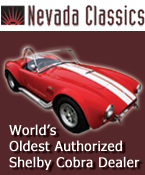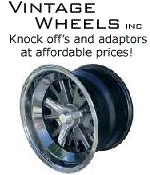 
 Main Menu
Main Menu
|
 Nevada Classics
Nevada Classics
|
 Advertise at CC
Advertise at CC
|
 January 2025
January 2025
|
| S |
M |
T |
W |
T |
F |
S |
| |
|
|
1 |
2 |
3 |
4 |
| 5 |
6 |
7 |
8 |
9 |
10 |
11 |
| 12 |
13 |
14 |
15 |
16 |
17 |
18 |
| 19 |
20 |
21 |
22 |
23 |
24 |
25 |
| 26 |
27 |
28 |
29 |
30 |
31 |
|
|
 CC Advertisers
CC Advertisers
|
|

08-04-2010, 05:40 AM
|
|
CC Member

|
|
|
Join Date: Dec 2001
Location: Louisville,
KY
Cobra Make, Engine: I'm Cobra-less!
Posts: 9,417
|
|

 Not Ranked
Not Ranked
 FAQ Regarding Cobra Drivetrain Setups
FAQ Regarding Cobra Drivetrain Setups
I get quite a few questions everyday regarding different clutch/bellhousing/transmission setups. I thought it may be helpful to start a thread so that everyone can reference it when needed. We can also add to it as we go.
****
Q: What is the difference between the TKO 500 and the TKO 600?
A: The TKO 500 is rated for 500 lb-ft of continuous torque. It features a 1-1/16x10 (same as your small input Toploader) input shaft and can be ordered optionally with a 1-1/8x26 input shaft. It has a 3.27:1 1st gear and a .68 overdrive.
The TKO 600 is rated for 600 lb-ft of continuous torque. It has a 1-1/8x26 input shaft. 1st gear is a 2.87:1 and you have two choices in overdrives: a .64 and a .82.
Q: Should I buy the TKO with a .82 overdrive or a .64 overdrive?
A: This depends on a lot of variables: 1. Where do you do your most driving? On a 55mph road or a 70mph interstate? 2. What's your rearend gear ratio? 3. What size rear tires are you running? 4. What size engine and what camshaft are you running?
This is really a customer-dependent question and it really needs to be addressed on an individual basis. Things like rearend gears and camshafts really play a big part in what overdrive is needed. You don't want to pull an engine down to 1800-2000 rpm with a rather lumpy camshaft. Your engine won't be happy.
Q: Why are TKOs offered with "short input shafts"?
A: A lot of guys are running stock bellhousings, Lakewood Toploader bellhousings, or Quicktime Toploader bellhousings. The input shaft on a Toploader is much shorter than a standard length TKO input shaft. To cure this, you can either use a bellhousing spacer or buy a TKO with a shortened input shaft. I'm not a fan of bellhousing spacers. If you're a Lakewood owner, you know that it's sometimes very hard to get them dialed in correctly. When you add a bellhousing spacer to that, you're stacking manufacturer tolerances and could be adding to your bellhousing misalignment. All in all, the price is about the same with either direction that you go.
ALWAYS check input shaft depth.
Q: Lakewood or Quicktime?
A: Both bellhousings are great bellhousings and up until several years ago, the Lakewood was the bell to have. However, in terms of weight (Q/T usually weighs HALF of what a Lakewood weighs), size, quality of manufacturing, and product availability (Need a blowproof bell for a Flathead V8? What about an FE to C4?) , the Quicktime wins hands down in my opinion.
Q: Do I need an SFI bellhousing?
A: I would recommend a blowproof bellhousing with any high performance application. With a brittle cast iron or aluminum bellhousing, there's not much between an exploding flywheel and your leg if something were to happen.
All the Lakewood bellhousings are explosion proof and come with an SFI decal.
The Quicktime bellhousings are offered in both SFI and non-SFI versions. HOWEVER, even their non-SFI bellhousings are able to contain a flywheel/clutch explosion at 10000 rpm. The only difference between their non-SFI bells and their SFI bells is that the SFI bells are bolted around the bottom perimeter and have the SFI decal. If you're racing at a sanctioned event, you'll need the decal. If you have a street Cobra and want the protection, you're more than likely going to have to cut the bottom inch off of a Lakewood or Quicktime SFI bell anyway for ground clearance, so just go with the non-SFI version.
Q: I'm running a big input Toploader and want to switch to a TKO 600. What all do I have to change?
A: You can keep your bellhousing and use a TKO with a shortened input shaft. You will have to change your clutch fork, throw out bearing, pressure plate, and clutch disc. There are 11.5"/12" pressure plates/clutch discs available for both 1-1/16x10 and 1-1/8x26 applications, so it's easy to find a combo that will bolt back up to your 427/428 flywheels.
Either the TKO shifter will need to be relocated or your shifter hole will need to be trimmed. Shifters are available to move the TKO handle up to 4" in almost any direction, so finding a different shifter is not a problem.
Q: What is the best aftermarket shifter for the TKO?
A: I really like the Steeda Tri-Ax. It has adjustable stops and is spring loaded for speed shifting. The MGW and the Red Roberts shifters are also nice pieces and the Roberts shifters can be custom ordered to put the handle exactly where you need it.
Q: How well does a TKO shift?
A: If you're used to a T5 or a Toploader, the TKO will be a little different for you, especially at first until it's broken in. Some of this is due to the shifter that comes with it, some of it is due to the preparation of the parts inside. We offer a "Sure Shift" option to the TKOs to help in this, where the transmission is disassembled, the surfaces of the engagement cones are enhanced, synchros and sliders are deburred, and the countershaft is reshimmed. If you buy a brand new TKO with this option, it will still carry the full factory warranty.
Q: Can you add to the torque capability of the TKO?
A: Yes, we offer a couple of different options to help the TKO hold more torque. We can effectively increase the torque capacity by about 10%.
Q: What clutch kit do I need?
A: This is one of those questions where you have to have every piece of the puzzle to answer. I would start by asking:
1. Is this a street car, street/strip, or race car?
2. What kind of pedal pressure can you tolerate?
3. What is the rearend ratio?
4. What transmission are you running?
5. What engine and flywheel are you using?
6. How much horsepower is your engine making?
7. Do you ever drag launch on slicks?
8. What method of clutch actuation are you using?
There are lots of different variables on picking the perfect clutch. A lot of guys with small blocks like to just pick the King Cobra clutch and find that several thousand miles down the road, the clutch is slipping and worn out. You need to match the clutch to the capability of the engine. You can get away with a little more on a Cobra since most of the cars weigh around 2500 lbs. Usually the tires will lose traction before a clutch has time to slip. However, a stock replacement clutch just won't cut the mustard on a 450-500 hp engine.
Pressure plates are offered in both diaphragm (multiple finger) and Long (3 finger) styles. Both style are available in a wide variety of clamping force arrangements. Generally, the Long style clutch will have a higher pedal pressure, but this always doesn't hold true and there are definitely ways around it.
Clutch discs are offered with many different friction materials, styles, and hubs.
Your typical stock replacement disc is a sprung hub disc with a full circumference of friction area and is made of an organic material. This is the disc that offers the very best street manners (no chatter or quick engagement) but will hold the least amount of power. You can upgrade the pressure plate to help with this, but you're limited to about 450hp unless you go with a twin disc setup.
From there on up, you run into Kevlar discs, sintered bronze, sintered iron, ceramic, paddle discs, non-sprung hubs, etc, etc.
Each combination of pressure plate and disc will give you a certain clutch capability and degree of streetability. It all can be custom matched to suit your specific application.
If you have a specific question to your situation, feel free to contact me. I can answer any question that you have.
Q: Can I run a really light flywheel and a button clutch on the street?
A: I get lots of questions about lightweight aluminum flywheels and clutch kits.
You'll get differing opinions, but here's my thoughts: I try to keep the weight down off the end of the crankshaft. However, there's a diminishing return when you run too light of a setup. An extremely light setup will cause you to have to slip the clutch a little more to get the car moving. On a Cobra, this isn't too big of an issue. However, you can tell the difference between a 35# flywheel and a 14# flywheel.
The difference is in the rotating momentum. When you're not slinging as much weight back there, the engine has to make up for it when you're trying to get a lot of weight moving. This is also application dependent and I would not recommend a 14# flywheel for a 302 with a 3.08 rearend. However, for a 428 and a 3.70, then I would probably say go for it.
On the button clutches: These are very light weight setups made for circle track or road racing. Most of them are 5.5" to 7.5" in diameter and are only available with very aggressive non-sprung discs.
When you combine hardly any rotating momentum with an aggressive disc, you find yourself having to dump the clutch to get the car moving. An aggressive disc will not slip at all....it's a light switch on engagement: on or off. When that happens and you have no rotating momentum, it makes for an interesting start from a red light.
****
I encourage anyone to call (502.759.1431), PM, or email me with any questions. If something else needs added here, I'll be happy to append some info.
I'm a dealer for McLeod, RAM, Hays, Lakewood, Quicktime, Moser, Strange, Wilwood, Fidanza, PRW, and Tremec. All parts and combinations are usually available and ready to ship, unless it's a custom built transmission.
I'm also an engine builder and offer many different small block and big block (385 and FE) engine combinations. Again, contact me with any questions that you have.
|
-
Advertising


08-04-2010, 06:37 AM
|
 |
CC Member

|
|
|
Join Date: Jul 2005
Location: Virginia Beach, Va & Port Charlotte, Fl.,
Posts: 2,287
|
|

 Not Ranked
Not Ranked
Great post Brent, with much needed info too!
__________________
Too many toys?? never!
|

08-04-2010, 07:08 AM
|
 |
CC Member

|
|
|
Join Date: Dec 2001
Location: Castalia,
Oh
Cobra Make, Engine: EM cobra, 450 inch sbc running a best ET of 9.14..so far..ALL MOTOR...approx 800 horse.............ERA with 482 FE..All Aluminum Engine
Posts: 1,395
|
|

 Not Ranked
Not Ranked
Very good info...  
__________________
Jack
XSSIVE .....
|

08-04-2010, 07:16 AM
|
|
CC Member

|
|
|
Join Date: Jan 2010
Cobra Make, Engine: AC cox 2699 roadster Riverside FIA RSR2001
Posts: 264
|
|

 Not Ranked
Not Ranked
Brent,
SBF 347 with a 164 teeth flywheel and a Tex racing GM T10. Do Quicktime do a bellhousing?
Ross
|

08-04-2010, 07:34 AM
|
|
CC Member

|
|
|
Join Date: Aug 2007
Location: Carlsbad,
Ca
Cobra Make, Engine: SPF 2932 with 438 Lykins Motorsports engine. Previous owner of FFR 5452.
Posts: 2,616
|
|

 Not Ranked
Not Ranked
If the input shaft on the TKO 600 is too long, what symptoms will the trans exhibit? Hard shifting? Grinding?
Will I still be able to bolt the trans and bellhousing completely to the engine if the input shaft is too long?
Will it eat up pilot bushings or just bottom out against the crank?
What should the clearance be between the engine and the input shaft after installation?
__________________
Jim
|

08-04-2010, 08:29 AM
|
 |
CC Member

|
|
|
Join Date: Jul 2005
Location: Bartlett,
Ill
Cobra Make, Engine: Everett-Morrison LS1
Posts: 2,448
|
|

 Not Ranked
Not Ranked
Good job Brent
you were being so thorough that I stopped reading about half way down
too bad Tremec didn't put out something like that
Jerry
|

08-04-2010, 08:58 AM
|
|
CC Member

|
|
|
Join Date: Dec 2001
Location: Louisville,
KY
Cobra Make, Engine: I'm Cobra-less!
Posts: 9,417
|
|

 Not Ranked
Not Ranked
Ross,
Quicktime's SBF bells are only compatible with 157T wheels.
JHV,
Hopefully the symptom would be that you can't bolt it up all the way. Otherwise a lot of damage could occur....if the input shaft pilot end pushes the crankshaft, you're looking at a smoked thrust bearing.
The difference between a T/L bell and TKO bell is about 3/4"....so the difference would be apparent. However, it's ALWAYS wise to check depth and to dial in the bellhousing.
Jerry,
I appreciate that. Thank you.
Last edited by blykins; 08-04-2010 at 09:01 AM..
|

08-04-2010, 10:30 AM
|
|
CC Member

|
|
|
Join Date: Sep 2009
Location: Ft. Worth,
TX
Cobra Make, Engine: LSC427, 427DartSHP
Posts: 154
|
|

 Not Ranked
Not Ranked
Nicely done Brent.
__________________
Sometimes things really do go as planned.
|

08-05-2010, 08:50 AM
|
|
CC Member

|
|
|
Join Date: Jul 2008
Location: Driftwood,
TX
Cobra Make, Engine: Contemporary Cobra, 427 side oiler
Posts: 1,850
|
|

 Not Ranked
Not Ranked

Great post Brent.
Quote:
Originally Posted by jhv48

If the input shaft on the TKO 600 is too long, what symptoms will the trans exhibit? Hard shifting? Grinding?
|
Well for starters the transmission might not mate up into the engine all the way, forcing you to pull them together which is verboten. Hard shifting and vibration may occur as well.
Quote:
Originally Posted by jhv48

Will I still be able to bolt the trans and bellhousing completely to the engine if the input shaft is too long?
|
Maybe, but you'll be putting thrust on the crank as well as the transmission input bearings and both are a big no-no.
Quote:
Originally Posted by jhv48

Will it eat up pilot bushings or just bottom out against the crank?
|
Yes. The pilot shaft tip will chase itself around the concave crank hole and it will wallow out the pilot bushing.
Quote:
Originally Posted by jhv48

What should the clearance be between the engine and the input shaft after installation?
|
I could never find a hard # on this so we went for 3/16". We mounted the BH up tight and stuck a thin rod into the center of the bushing hole and measured out to the face of the BH. We then did the opposite measuring from the transmission mounting surface out to the plane of the input shaft tip. I have read that some just grind it off but we chose to remove the shaft and have it machined to length and had the tip chamfered.
Your mileage may vary. 

|

08-05-2010, 09:25 AM
|
|
CC Member

|
|
|
Join Date: Feb 2004
Cobra Make, Engine: shellvalley 428 ford
Posts: 399
|
|

 Not Ranked
Not Ranked
Hi Brent,
As usual, very thoughtful and well written and full of information. Told me everything I ever wanted to know about this. As you know, I am still kicking this swap around. I just need to sell my big in/out T/L.
Later Gator
|

08-05-2010, 10:00 AM
|
|
Senior Club Cobra Member

|
|
|
Join Date: Jul 2002
Cobra Make, Engine:
Posts: 15,712
|
|

 Not Ranked
Not Ranked
Wait, I gotta sell mine first!!!  I went ahead with the swap so I wouldn't loose any down time (old trans out, new trans in) and now have the big in/big out with Hurst shifter hanging out in the garage. I suppose I should get around to listing for sale somewhere... |

08-05-2010, 12:18 PM
|
|
CC Member

|
|
|
Join Date: Jan 2005
Location: Rancho Cucamonga,
ca
Cobra Make, Engine: SPF 239
Posts: 820
|
|

 Not Ranked
Not Ranked

Brent,
Thank you for the all the intel, I appreciate it.
However I must disagree with your blanket endorsement of Quicktime.
I was involved in a discussion on 460ford.com about the failure of a non SFI Quicktime housing. ( http://www.460ford.com/forum/showthread.php?t=138991)
Its to bad the video of the failure is gone, because its quite dramatic. That the housing failed to contain the explosion is a problem, but in its defense, it is not an SFI certed housing.
My issue is that the company openly misleads the consumer into believing that this housing (and others) has passed the SFI test regimen, when it has not, and more importantly can not.
SFI requires the lower containment bolts. If they aren’t there, no cert.
When I wrote to Ross McCombs of Pres/Ceo of QT, all of his responses troubled me, never once would he just say, “Yea it sucks, without those lower containment bolts, you could have a major failure, at substantially less energy than the SFI tests at”, just marketing hype.
Im sure the SFI certed Quicktime housings work as designed, but its unfair to the consumer to say they (the non certed housing) offer similar protection.
Jason
Last edited by D-CEL; 08-06-2010 at 01:39 AM..
Reason: ommition
|

08-05-2010, 01:00 PM
|
|
CC Member

|
|
|
Join Date: Dec 2001
Location: Louisville,
KY
Cobra Make, Engine: I'm Cobra-less!
Posts: 9,417
|
|

 Not Ranked
Not Ranked

Jason,
To get an SFI approval, the bellhousings must pass a test where a flywheel is fractured and exploded at 10000 rpm. Now there are different versions of the SFI rating....6.1, etc. However, all of their bellhousings have passed a form of SFI testing and will contain a flywheel explosion. The SFI 6.1 rating requires the bolts at the bottom perimeter of the bellhousing.
I know of the very video that you were referring to. However, from what I remember, the bellhousing bolts pulled out of the block - there was no bellhousing failure. When there is nothing to support the bellhousing at the rear, any force inside of the bellhousing would push the bellhousing outward, pulling the bolts out of the block.
Even if it were definitely the bellhousing's fault (besides the blatant use of a cast iron flywheel on a extremely high horsepower engine), an aluminum or cast iron bellhousing would have had the same results, if not worse. Even when looking at the Lakewoods, most Cobra owners have to cut the bottom portion of the bellhousing off. Of course this voids the SFI validity and also cuts down the effectiveness of the block plate and perimeter bolts.
Last edited by blykins; 08-05-2010 at 01:02 PM..
|

08-05-2010, 01:57 PM
|
 |
CC Member

|
|
|
Join Date: Dec 2001
Cobra Make, Engine: BDR
Posts: 536
|
|

 Not Ranked
Not Ranked
This is some great stuff here, thanks for the informative post.
|

08-05-2010, 06:27 PM
|
|
CC Member

|
|
|
Join Date: Jan 2005
Location: Rancho Cucamonga,
ca
Cobra Make, Engine: SPF 239
Posts: 820
|
|

 Not Ranked
Not Ranked

Brent,
I am familiar with the SFI cert program, when you say :“all of their bellhousings have passed a form of SFI testing and will contain a flywheel explosion.”
I am confused, the housing that failed (RM-8010) HAS NOT PASSED any SFI testing according to the tech I spoke with and has at least once failed to contain a significantly lower energy failure than is required by the SFI process.
Because some Quicktime housings have passed, doesn’t mean they all meet the requirement. Does it?
The argument you are using is the same as Mr. McCombs. “The Housing failed because the block and other chassis pieces weren’t strong enough”
I will state again, the SFI test does not rely on additional items to ensure the housing integrity. The housing alone must contain the pieces. The reason of the lower lip containment bolts are required is to distribute the explosion energy over the greatest possible area. The bell housing bolts and dowel pins alone are not enough.
Then you go on to say “there was no housing failure” What? The flywheel exploded, the housing failed to contain the pieces. The SFI tech who watched the video with me called it as it was “a catastrophic failure of the housing.”
I would say if someone uses an inappropriate flywheel or cuts the bottom off of an SFI certed housing, they assume all the liability that goes with the decision. If a failure does occur, hopefully it will just be parts and dollars not limbs and life.
But that is a decision the owner made knowingly, not by being misled, thinking they were paying for a minimum level of safety.
Jason

|

08-05-2010, 06:49 PM
|
|
CC Member

|
|
|
Join Date: Dec 2001
Location: Louisville,
KY
Cobra Make, Engine: I'm Cobra-less!
Posts: 9,417
|
|

 Not Ranked
Not Ranked

Jason,
Quicktime advertises that every bellhousing they produce passes SFI testing. As you know, there are many flavors of SFI ratings, 6.1, 6.3, etc. However, for the bellhousing to pass SFI testing means that it will contain a flywheel explosion. They may not all be 6.1 rated (perimeter bolts, pretty sticker, etc), but they are all advertised to contain an explosion.
I really don't understand the instance of where the bellhousing separated from the block. That's kinda like saying that an oil pan is guaranteed to withstand a rotating assembly throwing a rod....then blaming the oil pan when the rod breaks the block above the pan and exits the engine. The bolts pulled out of the block. I don't see that as being the bellhousing's fault. If the bellhousing would have shattered into a million pieces, it would have been one thing....but pulling the threads out of the block and allowing the flywheel to slip in behind is another.
I guess we don't see eye to eye on this particular subject and that's absolutely fine....we're all allowed to have our own opinions. That's what makes us special....  |

08-05-2010, 11:02 PM
|
|
CC Member

|
|
|
Join Date: Jan 2005
Location: Rancho Cucamonga,
ca
Cobra Make, Engine: SPF 239
Posts: 820
|
|

 Not Ranked
Not Ranked

Brent,
Yes Quicktime advertises that and it leads many people (including retailers like yourself) to believe it to be true.
Why dont you call Ross McCombs and ask the question. What exactly does “passed SFI testing” mean?
Ask him part # RM-8010 has been tested by SFI and what the results were.
FYI, SFI 6.1 is the lowest level of certification for a housing.
Well lets talk about containment. Oil pans do exactly what they are designed for, containing oil. They were not designed to contain connecting rods during a failure.
However, Explosion proof bell housings were designed to contain exploding flywheels and clutches and to save the limbs and lives.
The only job of the housing is to contain the pieces, it can be completely destroyed, so long as nothing escapes containment it has done its job. The reason they created the SFI was to ensure continuity. So that the consumer knows they were getting the minimum level of safety they had paid for. That pretty sticker means exactly that.
There is a reason SFI requires the 8, ˝ -13 grade 8 lower containment bolts, they effectively create a box around the flywheel. With no lower bolts, there is no support on half of the housing. It is a clam shell that is easily pried apart and worse it’s held together by brittle cast iron or aluminum of the block.
To infer that both designs offer remotely similar containment is ludicrous.
once again, im fine with a lighter, smaller part for ground clearance or whatever, just dont mislead the public by say "has passed all SFItesting"
jason

|

08-06-2010, 12:55 AM
|
 |
Senior Club Cobra Member

|
|
|
Join Date: Dec 2007
Cobra Make, Engine: ERA FIA 'Street' Build
Posts: 2,128
|
|

 Not Ranked
Not Ranked
Let me jump in here and ask a side question ...
Does any manufacturer offer a SFI certified (with sticker) bell-housing for a SBF, that does not hang lower than 8", from the center line of the crankshaft, to the bottom edge of the bell housing flange?
Thanks.
|

08-06-2010, 05:31 AM
|
|
CC Member

|
|
|
Join Date: Dec 2001
Location: Louisville,
KY
Cobra Make, Engine: I'm Cobra-less!
Posts: 9,417
|
|

 Not Ranked
Not Ranked

Quote:
Originally Posted by D-CEL

Brent,
Yes Quicktime advertises that and it leads many people (including retailers like yourself) to believe it to be true.
Why dont you call Ross McCombs and ask the question. What exactly does “passed SFI testing” mean?
Ask him part # RM-8010 has been tested by SFI and what the results were.
FYI, SFI 6.1 is the lowest level of certification for a housing.
Well lets talk about containment. Oil pans do exactly what they are designed for, containing oil. They were not designed to contain connecting rods during a failure.
However, Explosion proof bell housings were designed to contain exploding flywheels and clutches and to save the limbs and lives.
The only job of the housing is to contain the pieces, it can be completely destroyed, so long as nothing escapes containment it has done its job. The reason they created the SFI was to ensure continuity. So that the consumer knows they were getting the minimum level of safety they had paid for. That pretty sticker means exactly that.
There is a reason SFI requires the 8, ˝ -13 grade 8 lower containment bolts, they effectively create a box around the flywheel. With no lower bolts, there is no support on half of the housing. It is a clam shell that is easily pried apart and worse it’s held together by brittle cast iron or aluminum of the block.
To infer that both designs offer remotely similar containment is ludicrous.
once again, im fine with a lighter, smaller part for ground clearance or whatever, just dont mislead the public by say "has passed all SFItesting"
jason |
I have talked to Ross on many occasions and we have had this discussion. He has told me all of his bells will contain a flywheel explosion at 10000 rpm.
A block plate (on an SFI 6.1 bellhousing) bolted around the bottom will keep the flywheel from exiting towards the bottom. It's not going to do anything to keep the threads from pulling out of the block at the top and separating the bellhousing from the rest of the engine.
We can argue this all day until we're blue in the face, but to me, it's a clear case of:
"I had a rattlesnake in a bag and the bag failed, causing the snake to get away."
"Well what happened? Did the bag split open or break?
"No, I dropped it and the snake got out."
Ross says that during SFI testing, the bellhousing is bolted to a 1" thick piece of steel. I'm not sure if all the mounting bolts are nutted or captured in threads (maybe you can answer that for us), but would it be the bellhousings fault if the bolts stripped out of the steel and caused a flywheel to escape? No, of course not....I would think that the SFI engineers would find a better way of conducting that test.
If you want to paste everything that Ross said in response to you, over from the 460 forum to here (well maybe into a separate thread), feel free to do so. However, this thread wasn't intended to be an in-depth discussion of Quicktime bellhousings.
It may also be fair to inquire to see if there has any been any failures with a Lakewood or McLeod bellhousing: particularly with 460 blocks since that's the only time I've ever heard of this kind of event happening and their specific design at the top of the block seems to cause a weakness.
If we had to have a beef with every manufacturer who has had a faulty part (again, I'm not saying Q/T is guilty in this), then we wouldn't be buying from anyone.
Lastly Darren, I hope you haven't taken any of this the wrong way. I'm not trying to be a punk by any means. However, looking at all of this fairly, I just simply don't agree with you.
TKB - Not that I'm aware of.
Last edited by blykins; 08-06-2010 at 05:35 AM..
|

08-06-2010, 10:34 AM
|
|
CC Member

|
|
|
Join Date: Jan 2005
Location: Rancho Cucamonga,
ca
Cobra Make, Engine: SPF 239
Posts: 820
|
|

 Not Ranked
Not Ranked

Brent,
I must say, you are now carrying the QT company flag well.
“He has told me all of his bells will contain a flywheel explosion at 10000 rpm.”
well this is clearly not the case, two documented failures in one thread. One 460, one windsor
But he (Mr. Mc Combs) still hasnt answered the question. Was this part number tested by SFI and did it pass? The web site says it has, why isn’t it certified?
Unfortunately, your analogy doesn’t hold water or snakes. When you say “No I dropped the bag” you lay blame on the owner.
According to my conversations with him, it was installed with the supplied hardware in as delivered condition.
Lets rewrite your quip it to be accurate:
“The bag, while nice to look at and smaller than the other bags on the market was clearly incapable of containing even small snake let alone the very large and dangerous snake as claimed in all of the bag manufacturers questionable if not downright misleading advertising.”
Yea, that’s better
I will say this again: It’s not about the failure or that QT does not design and produce a good part. I have no doubt that they have thousands of happy customers.
I have no problem selling a part that doesn’t meet the spec.
Just clearly and accurately depict the differences and don’t mislead your customers.
“Its smaller, lighter, generally cooler n every respect, However it does not have the containment capability of the SFI 6.1 certified designs”
Why is it that the truth so scary? Failures happen, I see them everyday, use them to learn and improve.
It is blindingly obvious the there is a market for a housing with the ground clearance of the QT but incorporating lower half containment.
Build it, test it, and Ill buy one.
Jason
p.s.
I meant to comment on the 1” thick steel plate vs block.
So is the block at fault? Absolutely not.
The bell housing bolt bosses on engine blocks were never designed to absorb failure impact as seen in a flywheel/clutch explosion. They are meant to hold the transmission on, nothing more. That is obvious.
The reason for a block plate is to absorb and distribute the energy, while isolating it from the block, hence the name “block saver”
If the plate is too thin, wrong material or lacks sufficient bolts to spread the energy over the largest possible area, every block will fail. Big or small, Chevy or Ford the block will fail.
I offer this, If the system QT has designed can only pass when its bolted to a 1” steel plate, Its not much good is it…
Last edited by D-CEL; 08-06-2010 at 11:33 AM..
|
 Posting Rules
Posting Rules
|
You may not post new threads
You may not post replies
You may not post attachments
You may not edit your posts
HTML code is Off
|
|
|
All times are GMT -7. The time now is 06:59 PM.
|






















 Linear Mode
Linear Mode



